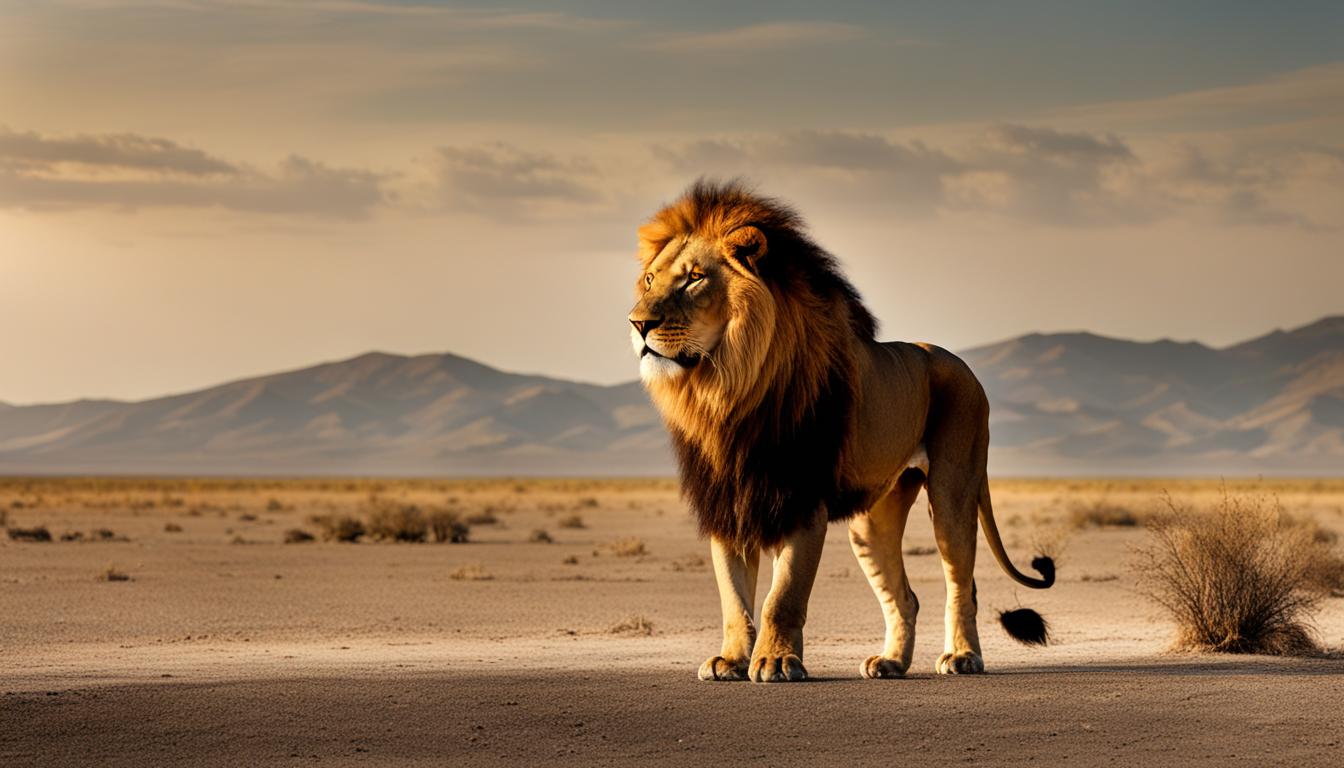Lions, majestic and iconic creatures, are facing significant challenges due to climate change in their natural habitats. The impact of climate change on lions is not limited to their survival alone but also affects the delicate balance of the ecosystems they inhabit. As climate patterns shift and extreme weather events become more frequent, lions are confronted with a range of threats that endanger their existence.
Climate change exacerbates the already critical issues of habitat destruction, human-wildlife conflict, and poaching. These combined stressors pose a grave danger to lion populations and the overall wildlife conservation efforts aimed at preserving biodiversity and ecosystem stability.
Key Takeaways:
- Lions face significant challenges due to climate change in their habitats.
- Climate change compounds the threats of habitat destruction, human-wildlife conflict, and poaching.
- Conservation efforts are crucial for safeguarding lion populations and preserving biodiversity.
- Climate change affects the delicate balance of ecosystems where lions play a key role.
- Preserving lion habitats and promoting coexistence between humans and lions are essential for their long-term survival.
The Impacts of Climate Change on Lion Populations
Climate change is having significant impacts on lion populations, threatening their survival and exacerbating existing conservation challenges. The changing weather patterns associated with climate change are causing shifts in lion habitats and disrupting the availability of critical resources such as food and water.
Rising temperatures and droughts can disrupt the reproductive cycles of lions, leading to population declines and increased risk of extinction. These changes also affect the availability of prey, as alterations in weather patterns can impact the abundance and distribution of herbivores, which are crucial for lion survival.
In addition to these direct effects, climate change also contributes to habitat destruction, which further compounds the challenges faced by lion populations. Human activities, such as deforestation and habitat encroachment, are driven by climate change and lead to the loss of lion habitats.
These combined impacts of climate change, habitat destruction, and prey scarcity pose a significant threat to lion populations and require urgent conservation actions. Efforts to protect lion populations must include habitat preservation, sustainable resource management, and community involvement to address the complex challenges posed by climate change and ensure the long-term survival of lions.
Human-Wildlife Conflict and Climate Change
Climate change not only poses direct threats to lion populations but also exacerbates existing human-wildlife conflicts. As climate change disrupts ecosystems and leads to habitat loss, lions are increasingly forced to come into contact with human settlements in search of food and water. This encroachment often results in conflict, as lions may prey on livestock when their natural prey becomes scarce. This conflict creates a dangerous cycle of retaliatory killings by humans, further endangering lion populations.
Habitat encroachment by human settlements is a significant contributor to the decline of lion populations. As human populations expand and encroach upon lion habitats, the available space for lions to roam and hunt is reduced. This fragmentation of their habitat can lead to isolated populations with limited genetic diversity, making them even more vulnerable to the impacts of climate change and other threats.
To address the increasing human-wildlife conflicts exacerbated by climate change, measures need to be taken to promote coexistence between humans and lions. Establishing effective livestock management practices, such as secure enclosures and predator deterrents, can help reduce livestock predation by lions and minimize conflicts. Additionally, education and awareness campaigns can help local communities understand the importance of conserving lions and the role they play in maintaining ecosystem balance.
| Challenges | Solutions |
|---|---|
| Habitat loss and fragmentation due to human settlements | Establish protected areas and wildlife corridors to preserve lion habitats |
| Livestock predation by lions | Implement livestock management practices such as secure enclosures and predator deterrents |
| Retaliatory killings by humans | Educate communities about the value of lions and the importance of conservation |
Addressing human-wildlife conflict and mitigating the impacts of climate change on lion populations require a multi-faceted approach. By implementing these solutions and fostering coexistence between humans and lions, we can help ensure the survival of lion populations while also preserving the delicate ecosystems they inhabit.
Threats to Lion Prey and Ecosystems
Climate change poses significant threats to lion populations by impacting the availability of prey and disrupting ecosystem stability. Changes in weather patterns can lead to shifts in herbivore populations, which in turn affects the food source for lions. The decline in prey availability not only directly threatens the survival of lions but also has cascading effects throughout the ecosystem.
A decline in prey populations can disrupt the competitive relationship between species, leading to imbalances in the ecosystem. As certain herbivores decrease in number, it can result in overgrazing of certain plant species, affecting vegetation patterns and reducing habitat quality for other species. This loss of biodiversity can have far-reaching consequences for the overall function and resilience of the ecosystem.
Impacts of Climate Change on Lion Prey
Climate change affects the availability of prey for lions in multiple ways. Changes in temperature and precipitation patterns can alter the distribution and abundance of herbivores, affecting their migratory patterns and foraging behavior. These changes can disrupt the timing of prey availability, making it more difficult for lions to effectively hunt and secure food.
| Threat | Impact |
|---|---|
| Shifts in prey distribution | Lions may need to venture into unfamiliar territories to find suitable food sources. |
| Reduced prey abundance | Lions may face increased competition for dwindling prey populations. |
| Altered migration patterns | Lions may struggle to intercept the movements of migratory prey species. |
These changes in prey availability can have detrimental effects on lion populations, as they rely on a consistent and adequate food supply to survive and reproduce. Understanding and addressing the threats to lion prey and ecosystems are crucial for conservation efforts aimed at safeguarding the future of these majestic creatures and the habitats they depend on.
Conservation Efforts to Protect Lion Populations
With the increasing threats posed by climate change, conservation organizations and governments have stepped up their efforts to protect lion populations and their habitats. By implementing various strategies, these stakeholders aim to mitigate the impacts of climate change and ensure the long-term survival of lions.
Habitat protection plays a crucial role in safeguarding lion populations. Conservationists work to preserve and restore lion habitats, creating safe spaces for these majestic creatures to thrive. This includes identifying and establishing protected areas, national parks, and wildlife reserves where lions can roam freely without disturbance.
Another important aspect of conservation efforts is the preservation of wildlife corridors. These corridors connect fragmented habitats, allowing lions and other wildlife to move between different areas in search of resources. By maintaining these corridors, conservationists enable genetic exchange and prevent inbreeding, ensuring the long-term viability of lion populations.
The enforcement of anti-poaching measures is also essential in protecting lion populations. Poaching remains a significant threat to lions, as their body parts are highly valued in illegal wildlife trade. Conservation organizations work closely with law enforcement agencies to crack down on poaching activities and disrupt the supply chain, aiming to reduce the demand for lion products and deter poachers from targeting these endangered animals.
| Conservation Efforts | Description |
|---|---|
| Habitat Protection | Preserving and restoring lion habitats through the creation of protected areas and national parks. |
| Wildlife Corridor Preservation | Maintaining corridors that connect fragmented habitats, allowing for genetic exchange and preventing inbreeding. |
| Anti-Poaching Measures | Enforcing laws and collaborating with law enforcement agencies to crack down on poaching activities and disrupt the illegal wildlife trade. |
These conservation efforts not only benefit lion populations but also contribute to the preservation of entire ecosystems. Lions are apex predators that play a crucial role in maintaining the balance and biodiversity of their habitats. By protecting lions, conservationists ensure the conservation of other species that rely on these apex predators for ecosystem stability.
Overall, the combination of habitat protection, wildlife corridor preservation, and anti-poaching measures forms a comprehensive approach to safeguarding lion populations in the face of climate change. Through these concerted efforts, conservationists strive to secure a future where lions can continue to roam free and thrive in their natural habitats.
The Role of Local Communities in Lion Conservation
When it comes to protecting lions in the face of climate change, community involvement plays a vital role. Local communities have unique knowledge and perspectives that can contribute to sustainable development and human-lion coexistence. By engaging with these communities, we can work together to ensure the survival of lions and their habitats for future generations.
Sustainable development initiatives are key in providing alternative livelihoods for communities that rely on resources within lion habitats. By offering education and training opportunities, we can empower individuals to pursue income-generating activities that are compatible with lion conservation. This not only reduces their dependence on natural resources but also creates a sense of ownership and responsibility towards protecting lions and their ecosystems.
In order to promote coexistence between humans and lions, awareness campaigns and educational programs are essential. These initiatives aim to foster understanding and appreciation of lions, their ecological importance, and the benefits of conserving their habitats. Additionally, establishing livestock management practices can help minimize conflicts between lions and communities. Implementing measures such as predator-proof enclosures and providing compensation for livestock losses can create a more harmonious relationship between humans and lions.
“The collaboration between local communities and conservation organizations is crucial in ensuring the long-term survival of lions. By actively involving communities in decision-making processes and empowering them as stewards of their natural resources, we can create a sustainable future where lions thrive despite the challenges of climate change.” – Dr. Jane Wilson, Lion Conservation Society
By recognizing the importance of local communities in lion conservation efforts, we can foster a sense of shared responsibility and create a more inclusive approach to conservation. Through sustainable development, education, and community engagement, we can build a future where humans and lions coexist, ensuring the continued existence of this iconic species.
Table: Examples of Community Involvement in Lion Conservation
| Initiative | Description |
|---|---|
| Community-led anti-poaching patrols | Empowering local communities to protect lions from poaching activities by establishing and supporting community-led anti-poaching patrols. |
| Establishment of conservation agreements | Collaborating with local communities to develop conservation agreements that outline responsibilities and benefits for both communities and lions. |
| Community-based ecotourism | Encouraging communities to engage in responsible ecotourism activities, providing economic incentives for lion conservation. |
| Environmental education programs | Implementing educational programs that raise awareness about lions and their conservation, targeting local schools and community centers. |
Mitigating Climate Change Impacts on Lions
As lions face the challenges posed by climate change, it becomes crucial to implement effective adaptation strategies to mitigate these impacts and ensure their survival. One key approach is the preservation of lion habitats. By protecting the areas where lions live, we can provide them with suitable environments where they can thrive despite changing climatic conditions.
Resource management also plays a significant role in mitigating the effects of climate change on lions. Regulating human activities within lion territories can help ensure that these majestic creatures have access to essential resources such as food, water, and safe migration routes. By carefully managing these resources, we can support lion populations and help them adapt to the evolving challenges they face.
The Importance of Collaboration and Research
Addressing the impact of climate change on lions requires collaborative efforts between conservation organizations, governments, and local communities. By working together, we can implement comprehensive conservation strategies and adapt them to changing circumstances. Ongoing research and monitoring are essential to gain a deeper understanding of the specific challenges faced by lions and to identify new adaptation techniques that can be employed to protect these magnificent animals.
| Adaptation Strategies for Lion Survival | Benefits |
|---|---|
| Preserving lion habitats | Ensures suitable environments for lions to thrive |
| Securing water resources | Provides essential hydration for lions and their prey |
| Protecting wildlife migration routes | Allows for natural movement and genetic diversity among lion populations |
| Regulating human activities in lion territories | Manages resource competition and reduces human-lion conflicts |
By implementing these adaptation strategies and fostering collaboration among stakeholders, we can work towards mitigating the impacts of climate change on lions and ensuring a future where these iconic creatures continue to roam our Earth.
Conclusion
The impact of climate change on lion populations is a pressing concern for wildlife conservation. Shifting weather patterns, habitat destruction, and increased human-wildlife conflict are contributing to a decline in lion populations and their ability to adapt to changing conditions.
Conservation efforts play a vital role in mitigating the effects of climate change on lions. By protecting lion habitats, implementing anti-poaching measures, and engaging local communities, we can support the long-term survival of these majestic creatures.
However, more research and adaptation strategies are needed to address the complex challenges posed by climate change. By continuing to study the impacts of climate change on lion populations and implementing effective conservation measures, we can strive to preserve their populations and ensure their ability to adapt to a changing world.
How does Climate Change Impact the Role of Lions in Shaping Ecosystems?
Climate change has a profound impact on the role of lions in shaping ecosystems. As temperatures rise, their habitats are altered, causing changes in the distribution and abundance of prey species. This affects the lions’ hunting behavior and can disrupt food chains within ecosystems. Furthermore, changing weather patterns and increased droughts may lead to reduced water availability, impacting the entire ecosystem and the survival of lions and other species that rely on these resources.
How Does Climate Change Impact the Behavior of Lions in the Wild?
Climate change is having a significant impact on the behavior of lions in prides. Rising temperatures and extreme weather events disrupt their natural habitats, forcing them to adapt their hunting and territorial patterns. Temperature increases also negatively affect their prey availability and water sources, leaving lions more vulnerable to starvation and dehydration. As a result, the behavior of lions in prides undergoes substantial changes as they struggle to navigate the challenges brought about by climate change.
FAQ
How does climate change affect lions in their habitats?
Climate change alters weather patterns, leading to changes in lion habitats and the availability of resources like food and water. Rising temperatures and droughts can disrupt their reproductive cycles, decrease prey availability, and increase the risk of diseases, ultimately posing extinction risks for lions.
How does climate change contribute to human-wildlife conflicts involving lions?
Climate change exacerbates existing conflicts as lions are forced to come into closer contact with human settlements due to disruptions in ecosystems and habitat loss. They may prey on livestock when their natural prey becomes scarce, leading to retaliatory killings and further conflict. Habitat encroachment by humans also contributes to the decline of lion populations.
What impact does climate change have on lion prey and ecosystems?
Climate change affects the availability of prey for lions, as changes in weather patterns can impact the abundance and distribution of herbivores. The decline in prey populations not only threatens the survival of lions but also disrupts ecosystem stability and biodiversity, leading to cascading effects throughout the ecosystem.
What are the conservation efforts to protect lion populations from climate change?
Conservation organizations and governments implement strategies such as habitat protection, wildlife corridor preservation, and the enforcement of anti-poaching measures. By safeguarding lion habitats and promoting ecological monitoring, conservationists aim to mitigate the impacts of climate change and ensure the long-term survival of lions.
How can local communities contribute to lion conservation in the face of climate change?
Engaging local communities in lion conservation is crucial. Sustainable development initiatives provide alternative livelihoods for communities that rely on resources in lion habitats. Promoting coexistence between humans and lions through education, awareness campaigns, and livestock management practices can reduce conflicts and support conservation efforts.
What adaptation strategies are essential to mitigate climate change impacts on lions?
Adaptation strategies include preserving lion habitats, securing water resources, and protecting wildlife migration routes. Effective resource management, such as regulating human activities in lion territories, helps ensure lions have access to essential resources despite changing climatic conditions.
How does climate change contribute to the decline of lion populations?
Climate change poses significant challenges to lion populations, contributing to habitat loss, prey scarcity, and increased human-wildlife conflict. Conservation efforts, such as habitat protection and community involvement, are crucial to mitigating these impacts and ensuring the survival of lions in the face of climate change.
What are the main objectives of lion conservation in the context of climate change?
The main objectives of lion conservation in the context of climate change are to protect their habitats, secure their food and water resources, and mitigate conflicts with humans. Continued research and adaptation strategies are needed to address the complex challenges that climate change presents for lion populations and their ecosystems.










